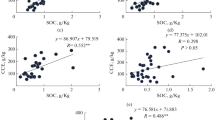Summary
A pot culture experiment was conducted to determine the CaCO3 percentage at which it exerts its drastic effect on plant growth, P32 and Fe uptake as a criterion for the definition of calcareous soils. Soil mixtures were prepared by mixing different calculated amounts of Nile loam, fine sand and fine oolitic sand to give mixtures containing 1, 2, 4, 6, 8, 10, 20, 30, 40, and 50% CaCO3. The mixtures were so prepared that their clay contents were equal and having the same texture. Corn plants were selected for this study.
The results of plant growth, P32, and Fe uptake supports each other and clearly indicate that when CaCO3 reaches 8 percent of the soil components, it controls its biological and chemical characteristics. A conclusion was drawn that 8% CaCO3 could be the margin at which the soil can be considered calcareous.
Similar content being viewed by others
References
Boischot, P., Coppenet, M., and Hebert, J., The fixation of phosphoric acid on calcium carbonate in soils. Plant and Soil 2, 311 (1950).
Cole, C. V., Olsen, S. R. and Scott, C. O., The nature of phosphate sorption on calcium carbonate. Soil Sci. Soc. Am. Proc. 17, 352 (1953).
Ensminger, L. E. and Larson, H. W. E., Carbonic acid soluble phosphorus and lime content of Idaho soils in relation to crop responce to phosphate fertilization. Soil Sci. 58, 253 (1944).
Hibbard, P. L., Factors influencing phosphate fixation in soils. Soil Sci. 39, 253 (1935).
Hilal, M. H., Anter, F., and El-Damaty, H., A chemical and biological appoach towards the definition of calcareous soils. 1. Movement and retention of Pat in soils as affected by percentage and particle size of calcium carbonate fraction. Plant and Soil 39, 469–478 (1973).
McGeorge, W. T., Factors influencing the availability of native soil phosphate and phosphate fertilizer in Arizona. soils. Arizona Agr. Expt. Sta. Tech. Bull. 82 (1939). 7McGeorge, W. T. and Breazeale, J. F., Phosphate solubility studies on some unproductive calcareous soils. Arizona Agr. Expt. Sta. Tech. Bull. 35 (1931).
McGeorge, W. T. and Beazeale, J. F., The relation of phosphate availability, soil permiability and carbon dioxide to the fertility of calcareous soils. Arizona Agr. Expt. Sta. Tech. Bull. 36 (1931).
Olsen, S. R., Measurements of surface phosphate on hydroxylaptite and phosphate rock with radiophosphorus. J. Phys. Chem. 56, 630 (1952).
Olsen, S. R. and Watanabe, F. S., A method to determine a phosphorus adsorption maximum as measured by Langmuir isotherm (1957).
Smith, V. T., An evaluation of carbon dioxide method of determining available phosphoric acid on high lime soil. J. Am. Soc. Agron. 40, 1045 (1948).
Thorne, D. W., Calcium carbonate and exchangeable sodium in relation to the growth and composion of plants. Soil Sci. Soc. Am. Proc. 11, 397 (1946).
Author information
Authors and Affiliations
Rights and permissions
About this article
Cite this article
Anter, F., Hilal, M.H. & El-Damaty, A.H. A chemical and biological approach towards the definition of calcareous soils. Plant Soil 39, 479–486 (1973). https://doi.org/10.1007/BF00264166
Received:
Revised:
Issue Date:
DOI: https://doi.org/10.1007/BF00264166




